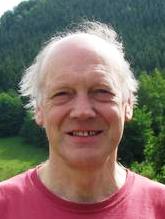
In probability theory and related fields, a stochastic or random process is a mathematical object usually defined as a family of random variables in a probability space, where the index of the family often has the interpretation of time. Stochastic processes are widely used as mathematical models of systems and phenomena that appear to vary in a random manner. Examples include the growth of a bacterial population, an electrical current fluctuating due to thermal noise, or the movement of a gas molecule. Stochastic processes have applications in many disciplines such as biology, chemistry, ecology, neuroscience, physics, image processing, signal processing, control theory, information theory, computer science, and telecommunications. Furthermore, seemingly random changes in financial markets have motivated the extensive use of stochastic processes in finance.

In statistical physics and mathematics, percolation theory describes the behavior of a network when nodes or links are added. This is a geometric type of phase transition, since at a critical fraction of addition the network of small, disconnected clusters merge into significantly larger connected, so-called spanning clusters. The applications of percolation theory to materials science and in many other disciplines are discussed here and in the articles Network theory and Percolation.

In mathematics, a random walk, sometimes known as a drunkard's walk, is a stochastic process that describes a path that consists of a succession of random steps on some mathematical space.

In physics, chemistry, and materials science, percolation refers to the movement and filtering of fluids through porous materials. It is described by Darcy's law. Broader applications have since been developed that cover connectivity of many systems modeled as lattices or graphs, analogous to connectivity of lattice components in the filtration problem that modulates capacity for percolation.

Béla Bollobás FRS is a Hungarian-born British mathematician who has worked in various areas of mathematics, including functional analysis, combinatorics, graph theory, and percolation. He was strongly influenced by Paul Erdős from the age of 14.

Oded Schramm was an Israeli-American mathematician known for the invention of the Schramm–Loewner evolution (SLE) and for working at the intersection of conformal field theory and probability theory.

In mathematics, a self-avoiding walk (SAW) is a sequence of moves on a lattice that does not visit the same point more than once. This is a special case of the graph theoretical notion of a path. A self-avoiding polygon (SAP) is a closed self-avoiding walk on a lattice. Very little is known rigorously about the self-avoiding walk from a mathematical perspective, although physicists have provided numerous conjectures that are believed to be true and are strongly supported by numerical simulations.
The Coxeter-James Prize is a mathematics award given by the Canadian Mathematical Society (CMS) to recognize outstanding contributions to mathematics by young mathematicians in Canada. First presented in 1978, the prize is named after two renowned Canadian mathematicians, Donald Coxeter and Ralph James.

Harry Kesten was a Jewish American mathematician best known for his work in probability, most notably on random walks on groups and graphs, random matrices, branching processes, and percolation theory.

Michael Aizenman is an American-Israeli mathematician and a physicist at Princeton University, working in the fields of mathematical physics, statistical mechanics, functional analysis and probability theory.

Geoffrey Richard GrimmettOLY is an English mathematician known for his work on the mathematics of random systems arising in probability theory and statistical mechanics, especially percolation theory and the contact process. He is the Professor of Mathematical Statistics in the Statistical Laboratory, University of Cambridge, and was the Master of Downing College, Cambridge, from 2013 to 2018.
Bálint Virág is a Hungarian mathematician working in Canada, known for his work in probability theory, particularly determinantal processes, random matrix theory, and random walks and other probabilistic questions on groups. He received his Ph.D. from U.C. Berkeley in 2000, under the direction of Yuval Peres, and was a post-doc at MIT. Since 2003 he has been a Canada research chair at the University of Toronto.

Kai Behrend is a German mathematician. He is a professor at the University of British Columbia in Vancouver, British Columbia, Canada.
Thomas C. Spencer is an American mathematical physicist, known in particular for important contributions to constructive quantum field theory, statistical mechanics, and spectral theory of random operators. He is an emeritus faculty member at the Institute for Advanced Study.
Joel Shalom Feldman is a Canadian mathematical physicist and mathematician.
Ruth Jeannette Williams is an Australian-born American mathematician at the University of California, San Diego where she holds the Charles Lee Powell Chair as a Distinguished Professor of Mathematics. Her research concerns probability theory and stochastic processes.

Hugo Duminil-Copin is a French mathematician specializing in probability theory. He was awarded the Fields Medal in 2022.

David Chandos Brydges is a mathematical physicist.

Roland Speicher is a German mathematician, known for his work on free probability theory. He is a professor at the Saarland University. After winning the 1979 German national competition Jugend forscht in the field of mathematics and computer science, Speicher studied physics and mathematics at the Universities of Saarbrücken, Freiburg and Heidelberg. He received in 1989 his doctorate from Heidelberg University under the supervision of Wilhelm Freiherr von Waldenfels with thesis Quantenstochastische Prozesse auf der Cuntz-Algebra. From 2000 to 2010 Speicher was a professor at Queen's University in Kingston, Ontario. Since 2010 he is at the University of the Saarland.

József Balogh is a Hungarian-American mathematician, specializing in graph theory and combinatorics.














